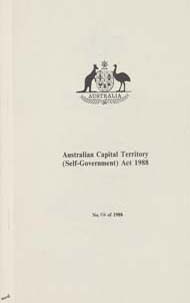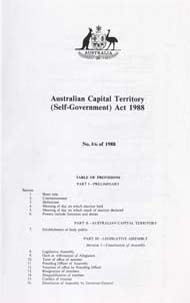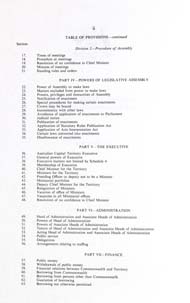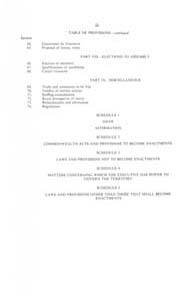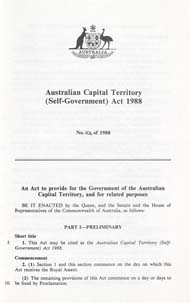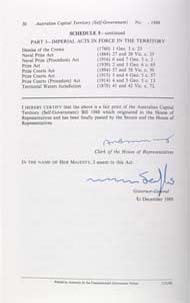

Australian Capital Territory (Self-Government) Act 1988 (Cth)
Significance
Enacted on 6 December 1988, this document establishes ‘a body politic under the Crown by the name of the Australian Capital Territory’ and is thus the Territory’s constitutional foundation. It provides for a fully elected legislature to make statutory law for the ACT, for an executive, and for the independent court system subsequently created under the ACT Supreme Court Transfer Act 1992.The provisions for the executive branch of government do not include a vice-regal post exercising authority as the representative of the Head of State. There is no role of Administrator, Governor or Governor-General, as in the state, Northern Territory and federal constitutions.
Instead, the functions of the head of the Executive – commissioning government, proroguing parliament and enacting legislation – are exercised by the Assembly itself and by the Chief Minister. Instead of vice-regal or regal assent, a Bill passed by the ACT Legislative Assembly is enacted on ‘notification’ – publication of a notice authorised by the Chief Minister, in the Government Gazette.
The Act created a body of ACT law out of the accumulation of laws derived from Commonwealth Executive Council Ordinances for the ACT made from 1911, Acts of the Commonwealth Parliament relevant to the ACT enacted since 1911, Acts of the British Parliament, and Acts of the New South Wales Parliament before 1911.
History
Three years after the seat of government was established at Canberra and after the opening of the first Parliament House in 1927, an ACT Advisory Council was established to administer the capital. In 1974 this became a fully elected Legislative Assembly, advising the Department of the Capital Territory.In 1979 this became a House of Assembly of 18 elected members, which was dissolved in 1986. The 17 members of the new Legislative Assembly met for the first time in May 1989. The machinery of self-government was built over several years with measures including establishing an ACT public service in 1994.
In 1978 a referendum on self-government was defeated, with 68 per cent of voters recording a ‘No’ vote. The federal Labor government of Prime Minister Bob Hawke set up a Self-Government Task Force in 1986 to report on the government of the ACT.
Although it was not self-governing, unusually, the ACT had its own police force. Then, in 1979, the ACT police combined with the Commonwealth Police and the Federal Narcotics Bureau to form the Australian Federal Police (AFP). Since 1988, the ACT government has contracted for the AFP to police the Territory.
Sources
Grundy, Philip et al, Reluctant Democrats: The Transition to Self-Government in the Australian Capital Territory, Federal Capital Press, Fyshwick, 1996.
Halligan, John and Wettenhall, Roger (eds), A Decade of Self-Government in the ACT, University of Canberra, Canberra, 2000.
Description
| Long Title: | An Act to Provide for the Government of the Australian Capital Territory, and for related purposes (Act 106 of 1988) |
| No. of pages: | Cover + 30 pages |
| Medium: | Paper |
| Measurements: | 32 x 20.1 cm |
| Provenance: | House of Representatives |
| Features: | The Assent signature of the Governor-General Ninian Stephen on page 30 – and a correction by hand on page 29 |
| Location & Copyright: | National Archives of Australia |
| Reference: | NAA: A1559, 1988/106 |
